1637

Johan Maurits fleet - etching made from a
drawing by Frans Post illustrating Gaspar Barleus book "Rerum per Octennium
in Brasilia"

Mauritsstaad by Frans Post
|
Johan Maurits arrives in Recife with artists Frans Post (1612-1680)
and Albert Eckhout (1610-1665), his privater doctor, the naturalist Willem
Piso (1611-1675). His statestmanlike program includes the creation of a great
colonial empire, reconciliation between the Dutch and Portuguese, the grant
of religious toleration and limited participation of the colonists in the
government. Distinguished artists and scientists are invited to make known
to Europe the resources and beauties of Brazil. In this same year a new city,
Mauritsstaad or Mauritiopolis starts to be built. Porto Calvo (Alagoas) is
conquered ,the province of Sergipe del Rey and Ceará are occupied. .
|
1638
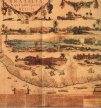
Brasilia Qua Parte Belgis etching by George
Marcgrave
map of Brazilian territory under the Dutch
|
Brazilian government opens the sugar trade to all Dutch merchants and Luso-Brazilians
from Nieuw Holland .
Naturalist, cartographer and astronomer George Marcgrave arrives in Recife.
He is the first astronomer of the Southern Hemisphere to make regular observations.
He builds the first astronomic observatory and meteorological station in the
Americas
|
1640
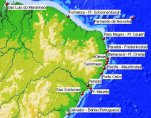
map of Dutch Brazil
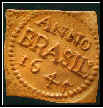 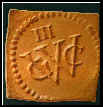
|
Portugal revolts against Spain, restores its independence and the Duke of Bragança
is proclaimed King. When Johan Maurits receives the news he celebrates it with
festivities .
The Dutch control half of the then Brazilian provinces: Maranhão, Ceará,
Rio Grande do Norte, Paraíba, Itamaracá, Pernambuco, Alagoas and Sergipe.
The Dutch are, at this time, the masters of the Atlantic Ocean and Recife
is, like Batavia in the East, the capital of the WIC (West Indische Compagnie)
empire.
|
1641-1642

Vrijburg Palace by Frans Post
|
Johan Maurits builds the Friburgum Palace - Castle of Freedom, on two
large sites ( Boa Vista and Vrijburg) that include the observatory and zoological
and botannical gardens. |
1642
|
News of truce between Portugal and the Netherlands.T he directors of
the WIC write to Johan Maurits informing him to return to Holland in the spring
of 1643. He is not happy and postpones his departure until May 1644. The province
of Maranhão revolts and after one year of fighting the Dutch troops retreat.
|
1644
|
End of construction of bridge between Recife and Antonio Vaz islands projected
by Jewish engineer Baltazar da Fonseca. Johan Maurits goes back to Europe.Deprived
of his leadership , the WIC loses control over the colony. |
1645
|
Andre Vidal de Negreiros leads the Insurrection of Pernambuco and defeats the
Dutch at Mount Tabocas.The fortress at Cape St Augustine,Fort of Porto Calvo,Fort
Maurits on the São Francisco River also surrender during the year.Sergipe del
Rey in turn rises against the Dutch and at the end of the year 1645 the Dutch
possess only Recife and, in its vicinity the Forts of Cabedello (Paraibá) and
Ceulen (Rio Grande do Norte), and the islands of Itamaracá and Fernando de
Noronha. Johan Maurits palaces and parks and many other buildings at Mauritsstad
are razed to the ground for a better defense of Recife. |
1646
|
Dutch block the northeastern coast of Brazil. Dutch government allows WIC ships
to intercept Portuguese vessels heading to Pernambuco |
1647
|
The Dutch occupy Itaparica island and surround Salvador in Bahia. Frederic
Henry of Nassau, prince of Orange and Stadhouder of the United Provinces dies.
Gaspar Barleus book "Rerum Per Octennium in Brasilia" is published.
|
1648
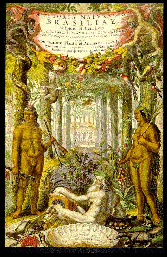
"Historia Naturalis Brasiliae"
|
First Battle of Guararapes. Witte de With army arrives in Recife and is defeated
by the Portuguese.
The book "Historia Naturalis Brasiliae"by Willem Piso and George
Marcgrave is published in Amsterdam.
|
1649 - 1650
|
Second battle of Guararapes with overwhelming victory for the Portuguese. Witte
de With leaves Brazil The situation of the Dutch in Recife, closely besieged
by land, is very precarious, and the 3000 men garrison demoralized.The shortage
of food and provisions is the worst enemy. |
1654
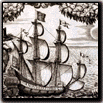
Allegory of the victory over the Dutch on
the cover of the book by Francisco de Brito Freire, Nova Lusitania, Historia
da Guerra Brasilica a Purissima Alma e Saudosa memoria do Serenissimo Principe
Dom Theodosio Principe de Portugal, e principe do Brasil.
(Lisbon, João Galrão, 1675).
|
The Dutch ask for terms of surrender, and on 26th January capitulation is signed
at Campina da Taborda. Not only Recife but all the places still in Dutch hands
are included (Paraìba, Ceará, Rio Grande do Norte, Itamaracá, Fernando de Noronha).
The Portuguese make their triumphal entry into Recife on 28th January. It is
the end of the Dutch colonial empire in Brazil. |







